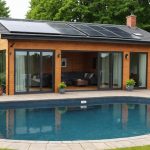As UK homeowners, you’re likely always seeking ways to reduce your household bills, and with the rising energy prices, heating bills are a particular concern. One of the less thought-about yet effective ways to trim down your heating expenses is by correctly selecting and using energy-efficient window treatments. The right window treatments can help insulate your home, prevent heat loss, and ultimately reduce your heating bills. This article will highlight several energy-efficient window treatments that can help keep your UK homes warmer and your pockets fuller.
The Impact of Window Treatments on Your Home’s Energy Efficiency
Before diving into the specific types of window treatments, let’s first understand how they can directly impact your home’s energy efficiency and the process behind it.
Lire également : What are the essential considerations for designing a pet-friendly UK home interior?
The windows in your house play a significant role in determining the amount of heat that escapes and enters your home. They can contribute to almost 25% of the total heat loss. Therefore, installing window treatments can improve your home’s insulation, minimise heat loss, and reduce your dependence on heating systems, thus saving energy and money.
Temperature control is the key here. During winter, window coverings can trap warm air inside, reducing the need for artificial heating. Similarly, in summer, they can block out the sun’s rays, preventing your home from overheating and reducing the need for air conditioning.
Cela peut vous intéresser : What are the best native UK plants for a low-maintenance garden?
Energy-Efficient Blinds and Shutters
Blinds and shutters are not just there for aesthetic appeal; they can also contribute significantly to your home’s energy efficiency.
Standard blinds offer a moderate amount of insulation but upgrading to energy-efficient blinds can greatly improve your heat saving. The design of these blinds includes honeycomb structures, also known as cellular blinds, that trap air within their cells, forming a barrier against window heat loss.
Similarly, shutters, especially those made of wood, offer excellent insulation. They fit tightly into window frames, leaving minimal space for air to escape. Thermal shutters are also available, designed with a layer of insulating material to increase their efficiency.
Another popular choice is roller shutters. They offer superior insulation as they create a pocket of air between the window and the shutter, acting as an additional layer of insulation.
Solar Energy Gain with Window Films
Solar control window films can be an excellent choice for your home as they can reduce heat gain and loss. These films contain tiny particles that reflect or absorb up to 80% of the sun’s heat, redirecting it away from your home. As a result, they can prevent overheating during summer and reduce the need for air conditioning.
In winter, these films can help retain indoor heat. They allow sunlight to pass through, providing natural light and warmth, but trap the heat inside, reducing the need for artificial heating. Not only do they make your home more comfortable, but they also trim down your heating bills.
Curtains And Drapes For Heat Insulation
While they may seem like simple decorative elements, curtains and drapes can greatly contribute to your home’s energy efficiency.
Thermal curtains and drapes are made of heavier materials with multiple layers to insulate windows. They prevent warm air from escaping during winter and block out heat during summer. The effectiveness of thermal curtains can be increased by ensuring they are hung as close to the window as possible.
Blackout curtains are another excellent choice for energy savings. They contain a light-blocking layer that reduces heat gain in summer by blocking out sunlight. During winter, they help keep warm air inside, reducing the need for heating.
The Role of Window Coverings
Even the simplest and most affordable of window coverings can help with energy efficiency. Simple window shades can be an effective solution for reducing heat gain in summer. They are easy to install and use, and when fully drawn, they can block out sunlight and keep your home cooler.
Reflective shades, on the other hand, have a reflective surface facing the window, deflecting the sun’s heat away from the room. These can be particularly effective in rooms with large, sun-facing windows.
In conclusion, the importance of having energy-efficient window treatments in your UK homes cannot be overstated. Not only do they contribute to a more comfortable living environment, but they also yield significant savings on your energy bills. It’s a win-win situation that certainly merits your consideration and investment.
Maintaining Natural Light with Energy-Efficient Window Treatments
When considering energy-efficient window treatments, it’s vital to maintain a balance between reducing heat loss and allowing natural light into your home. A well-lit home can significantly reduce the reliance on artificial lighting, leading to energy savings. Let’s explore some options.
Dual-shade blinds offer a perfect solution. They feature a reflective surface on one side (usually white) and an absorbent surface on the other (dark in colour). The reflective side can be used in the summer to deflect the solar heat, while the dark side can absorb the heat during the winter, providing additional warmth.
Another great option is solar shades or screen shades. These shades are designed to filter natural light, reduce glare, and maintain an outside view while blocking UV rays. They allow the entry of natural light but minimise heat gain, providing a comfortable, energy-efficient environment.
Curtains and blinds with light-coloured, reflective backing also contribute to energy efficiency. They reflect sunlight back outside, preventing heat gain in summer. In winter, they can be opened during the day to let in sunlight and closed at night to retain heat.
The Role of Smart Window Treatments in Energy Efficiency
With advances in technology, smart window treatments have become increasingly popular. They provide a high level of control over light and heat gain, increase energy efficiency, and save money on energy bills.
Programmable window treatments can be set to open and close at certain times of the day, maximising natural light and heat during the day and reducing heat loss at night. They are compatible with most types of window covering, including blinds, curtains, and shutters.
Motorised window treatments provide an even higher level of control. They can be operated remotely or set to respond to environmental factors such as temperature or sunlight levels. This means they can adjust themselves automatically to optimise energy efficiency throughout the day.
In Conclusion
With rising energy costs, improving energy efficiency in our homes is becoming more important. Energy-efficient window treatments provide an effective way to better insulate homes, reduce heat gain and loss, and ultimately save money on heating bills.
The variety of window treatments available, from efficient blinds and curtains to solar control window films and smart window treatments, means there are options to suit every home and budget. They not only reduce our carbon footprint but also enhance comfort and keep our homes well-lit in a natural, cost-effective way.
Incorporating these treatments into your home can be a smart step towards a more energy-efficient, money-saving, and comfortable living environment. Remember, the right window treatment choice can make a significant difference to your home’s energy efficiency. So, explore these options and make your UK home warmer and more energy-efficient.











